As I was heading to Las Vegas to test ride the Harley-Davidson CVO Road Glide ST, I had plenty of questions, but two were taking up the most rental space in my mind. One practical, one personal.
First, given the rapid rise of the MotoAmerica King of the Baggers series and the surge of attention it has won, just how far would Harley-Davidson go in trying to leverage its sizable investment in the series by putting a true performance bagger on showroom floors for customers to buy? And second, considering that the list price of the CVO Road Glide ST is just a dollar under $43,000, the claimed wet weight is 838 pounds, and it would easily be the fastest Harley-Davidson I’ve ever ridden, would it be a handful for a day on the track?
The first question was answered by Harley-Davidson designers and engineers over breakfast, and the second was answered as we spent the rest of the day on the small road course outside the oval at Las Vegas Motor Speedway. In both cases, the oversimplified version of the answer was “maybe a little less than you’d expect.”
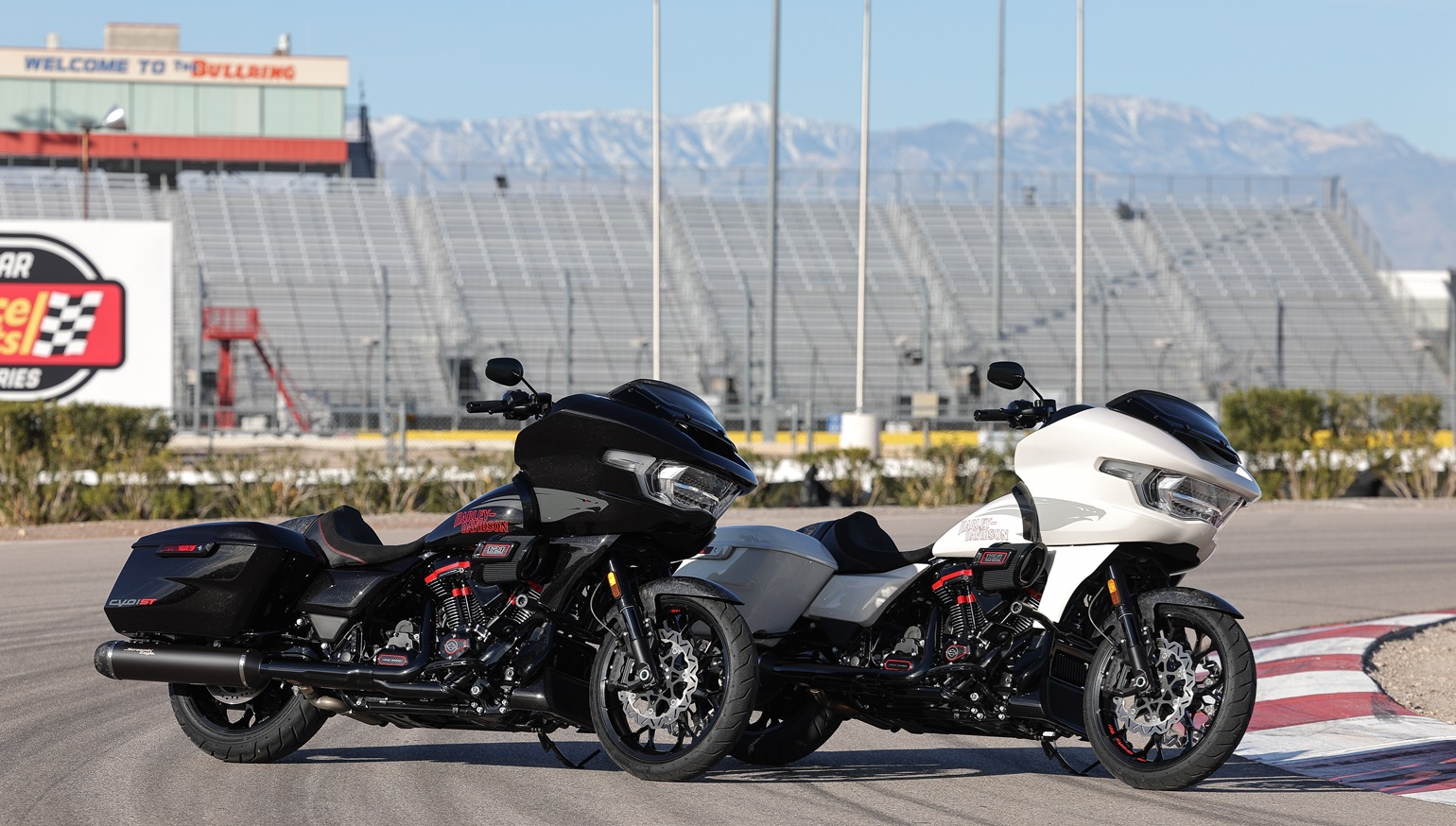
Harley-Davidson chose two high-quality but relatively understated color treatments for the CVO Road Glide ST, rather than going with a theme that brings to mind the King of the Baggers factory race bike. Photo by Brian J. Nelson.
Setting the stage: CVO and KOTB
Harley-Davidson has been making CVO (for Custom Vehicle Operations) models for a quarter of a century, now. They’re distinguished by upgraded components, top-of-the-line performance for Harley-Davidson models, the best paint jobs you’ll see on a production motorcycle anywhere, exclusivity due to limited numbers produced, and prices that mean only a limited number of consumers could consider buying one anyway. Naturally, the 2024 CVO Road Glide ST carries on all those traits.
King of the Baggers is a much newer phenomenon, and it’s impressive how fast it has risen. Begun with a one-off race in 2021, the series consists of 18 races this year, including as a support race for the Red Bull Grand Prix of the Americas MotoGP race at Circuit of the Americas in April. I believe there’s no question that KOTB has achieved its mission of drawing huge attention to MotoAmerica, especially from fans who might not be able to tell the difference between a GSX-R1000R and a Panigale V4R. Get them in the gate to see the baggers and some of them might just find out how much fun a day at the races can be.
Meanwhile, it has been equally astonishing to see the rapid development of the racing baggers. As I noted in response to a reader comment over on Common Tread at RevZilla, the pole time for that first baggers race at Laguna Seca in 2021 was 1:33.731. In 2023, it was 1:28.617. That’s massive advancement, and the 620-pound baggers are now just a second or two off the lap times of the highly developed MotoAmerica Supersport bikes at many tracks. At Daytona this year, the highest recorded speeds on the high banks were not the Supersport bikes in the Daytona 200, but the baggers, some of which hit 185.5 mph.

I never got the chance to ride the CVO Road Glide ST on the street, as Harley-Davidson introduced the bike on the road course outside Las Vegas Motor Speedway. Photo by Kevin Wing.
Prior to KOTB, the only place Indian and Harley-Davidson were competing on the race track was in American Flat Track. No one at either company has ever said so officially, and I doubt they ever would, but it’s pretty clear to me that Indian and Harley-Davidson have shifted their priorities and spending to KOTB, because of the greater attention it’s getting them.
All that leads to my first question: When are we going to see a King of the Baggers edition performance bagger in a Harley-Davidson showroom so the company can cash in a little on that investment in racing? Would the CVO Road Glide ST be that bike I’ve been expecting?
The answer is “not quite.” Vice President of Design Brad Richards noted that this bike was developed entirely after Harley-Davidson began participating in King of the Baggers, and he added, “We’ve been wanting to create an ST version in our CVO line for a long time.” But, the Harley-Davidson engineers and designers working on the CVO Road Glide ST ultimately chose a middle path between a performance-focused bagger closer to the race bike and a comfortable, sophisticated bagger for the street that would fit in better with CVO tradition.
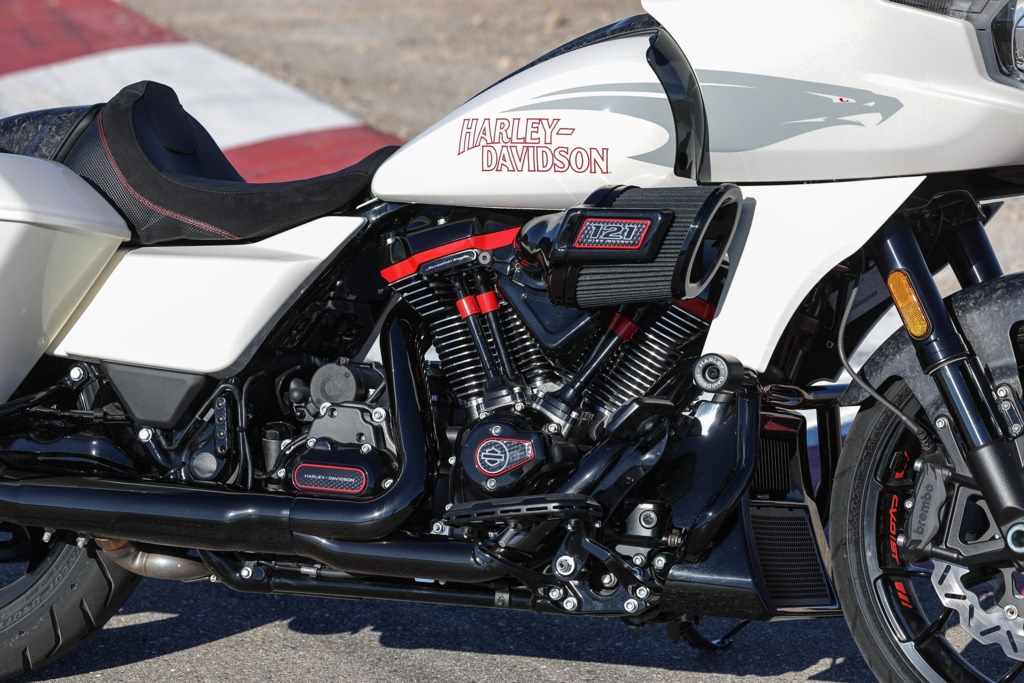
The Harley-Davidson 121 HO engine gives up variable valve timing in exchange for greater peak horsepower and a higher redline. Those aren’t typical Harley-Davidson V-twin attributes, but when you’re trying to build a racier bagger, they make perfect sense. Photo by Brian J. Nelson.
CVO Road Glide ST nuts and bolts
In the balancing act between performance and comfortable convenience, the choice of engine was one that tips toward performance. The CVO Road Glide ST gets a Milwaukee-Eight 121 High Output engine that lacks the variable valve timing in the 121 VVT. Why take away a feature for a premium CVO model? Because the purpose of variable valve timing is to provide a broader spread of power that provides both low-end torque and good top-end power. You don’t see variable valve timing in a race engine because it’s all about maximum horsepower, and that’s the direction the CVO went.
“You’re going to feel like this is a race tune,” said Richards.
The 121 HO engine redlines at 5,900 rpm, compared to the 5,600 rpm of the 121 VVT. To take full advantage, engineers revised the air intake, which they said flows 26% more air than the 121 VVT. Harley-Davidson claims 127 horsepower at 4,900 rpm and 145 foot-pounds of torque for the CVO, the highest torque figure of any Harley-Davidson production engine. The Milwaukee-Eight HO still has liquid-cooled heads and air-cooled cylinders. The cooling system sends water to the hotter rear cylinder first and the radiator is painted black and made as unobtrusive as possible to keep the traditional air-cooled look.
Showa suspension is fully adjustable, front and rear, and Brembo four-piston calipers and wave-style rotors provide sophisticated stopping apparatus. Front and rear brakes are electronically linked, depending on the ride mode, which I’ll explain later.
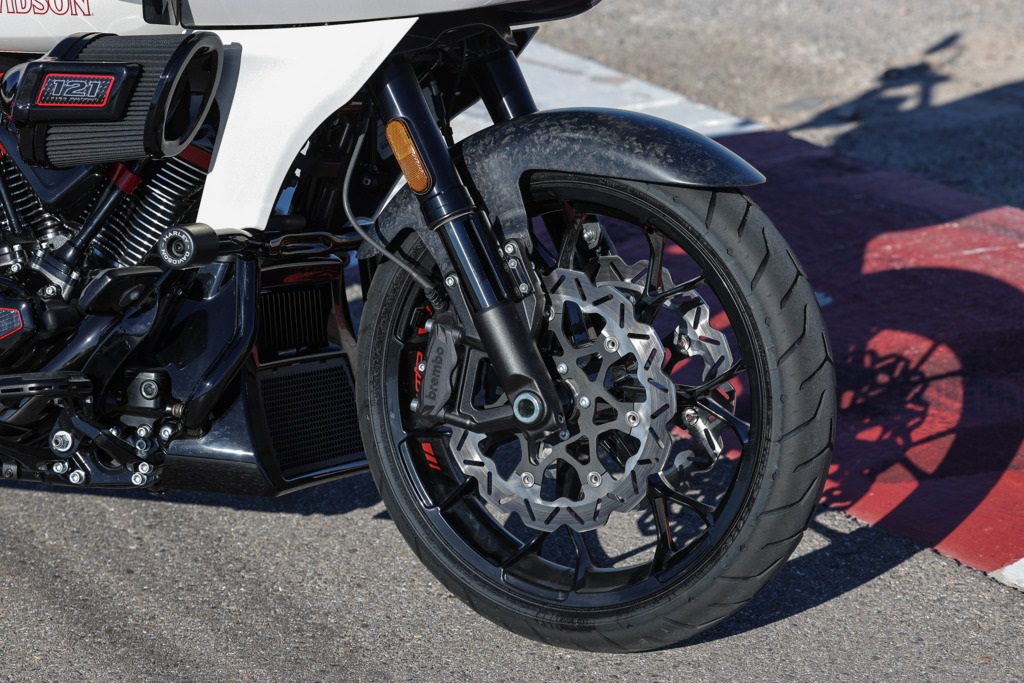
The Brembo brakes and wave-style rotors provide enough stopping power even for an 838-pound bagger set loose on a track. Note the forged carbon fiber fender. It shaves a few pounds, but also provides a unique look, different from the usual carbon fiber weave. Photo by Brian J. Nelson.
There’s no getting around the fact that 838 pounds is a lot of weight for that engine to push and the brakes to stop. Still, it could be worse. That weight is only six pounds less than the 2023 (non-CVO) Road Glide ST, but it’s a significant 60 pounds lighter than the 2022 CVO Road Glide, since CVO models often carry extra equipment. To trim some weight, Harley-Davidson used some forged carbon fiber pieces (which also add a unique look) for the seat cowl and front fender, titanium shells in the mufflers, an oil pan made of lightweight composite, thinner metal in the fuel tank, and other touches.
But in other ways, Harley-Davidson shied away from trying to make the CVO Road Glide ST seem too much like a Spartan race bike. You get features such as a huge touchscreen display that can be configured multiple ways, whether you want performance information highlighted or integrated navigation or entertainment via the Rockford Fosgate Stage II audio system with a 500-watt amplifier and twin speakers in the frame-mounted fairing. Maybe the CVO Road Glide ST’s engine is supposed to make you think “race tune,” but the features and finish are supposed to make you feel like you’re settling into a luxury car.
I would go further and say that even the choice of paint reflects the back and forth between the two directions the designers were pulled. The Golden White Pearl and Raven Metallic paint options are the kind of unique and top-quality treatments all CVO models get. But the design team could have easily gone for a black-and-orange motif to bring to mind the KOTB race bikes, if they were trying to get buyers to make that connection. Instead, about the only nod to racing is a discrete “Fast Johnnie” logo on the side that dates back to Harley’s board-track racing days. The Screamin’ Eagle logo on the side is white on white (or black on black). This is not a motorcycle screaming “Look at me, I’m a race bike!”
But, Harley-Davidson did choose to have us ride it on a track, not on the street. And that would answer my second big question.
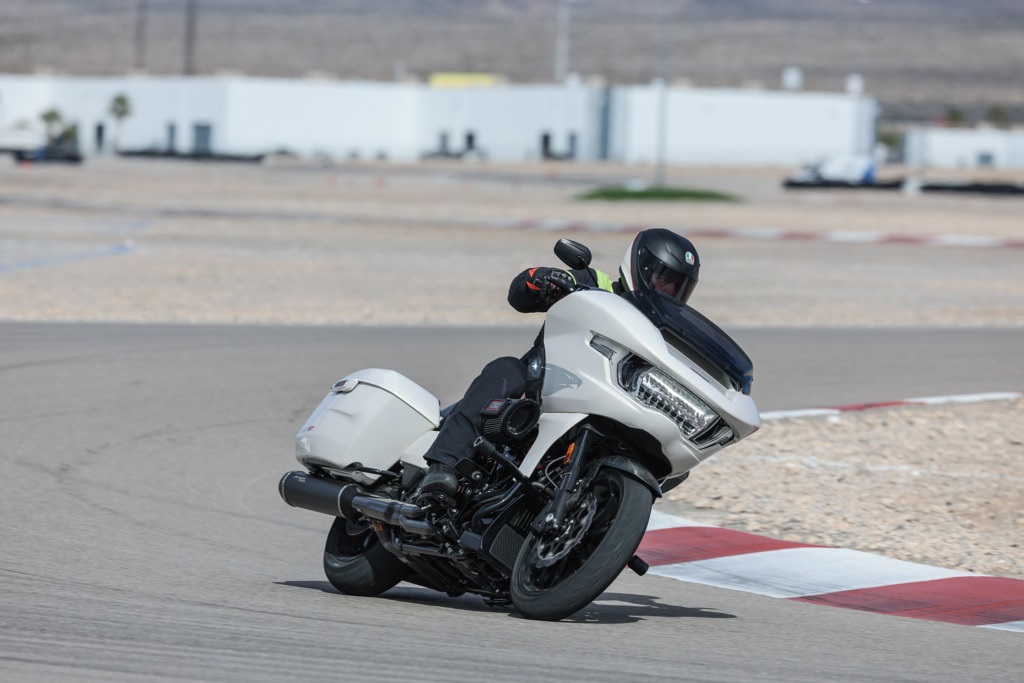
I suspect few owners will actually take their CVO Road Glide STs to a track day, but you certainly can. Testing the CVO Road Glide ST on the track instead of the street no doubt colored my perceptions. There are a few things about the motorcycle that hold back its performance on track (and the weight isn’t even the biggest one) that I wouldn’t have noticed so much on a street ride. Photo by Brian J. Nelson.
Riding the 2024 Harley-Davidson CVO Road Glide ST
My evaluation of the CVO Road Glide ST is limited and certainly colored by the fact we rode it on the track. There didn’t seem to be much reason to try the navigation while circulating a 2.4-mile road course over and over, and I didn’t have any extra mental bandwidth for dialing in some tunes on the stereo. So given the setting, I focused on how the motorcycle performed.
Maybe I have an overactive imagination, but I envision Harley-Davidson PR Manager Paul James waking up from a nightmare about what could happen if a pack of motorcycle writers, YouTubers, and Instagram influencers were unleashed without supervision on the track on $43,000 baggers. Maybe that’s why we were limited to turning laps behind the lead of James Rispoli, the new member of the Harley-Davidson Screamin’ Eagle factory racing team, and Travis Wyman, who will be riding for the Saddlemen team in KOTB this year. Also, whether the purpose was to slow us down on the back straight or give us a taste of real-world conditions, they also set up cones and made us do two tight U-turns each lap. As a result, I spent little time above third gear and the highest indicated speed I saw was 88 mph (I’m told top speed is a governed 120 mph). The day felt more like a spirited street ride than a wide-open track day.
From the start, my first impression was my surprise at how little effort I had to put into the handlebar to tip the 838-pound bagger into the corners of the tightly coiled road course. I was half expecting to have to wrestle the big bagger to get it to turn, but the handling pleasantly surprised me. While the bike is undeniably heavy, it doesn’t handle heavily at speed. Similarly, the Brembo brakes have enough power and feel to overcome all the weight they are called on to stop. The Harley team set up the Showa suspension for a rider of about my weight, with gear, and I never felt any need to make adjustments. I can’t say how the suspension works on the more varied conditions of real-world roads. The ST still only has three inches of rear suspension travel. But the bike felt solid, stable, and planted on the track.
The ST comes with Road, Sport, Rain, Track, and Track Plus modes, and the rider can also create four custom modes by selecting combinations of different levels of torque delivery, engine braking, throttle response, cornering traction control intervention, and cornering anti-lock braking intervention. In the first session, with the ST set to Sport mode, the bike would leap off the line at the crack of the throttle. I can safely say I haven’t ridden a motorcycle of this type that was faster.
After that first session, Harley-Davidson factory KOTB rider Kyle Wyman told us that Track mode on the CVO provides the same throttle response he prefers on his race bike, which actually has a softer hit at smaller throttle openings. Softening power delivery for a race bike may seem counterintuitive, but it makes perfect sense when you think about it. When you’re transitioning from full lean to upright and eager to get on the gas, you don’t want a sudden hit of power. During my second session, I set the ST in Track mode and I felt like it was significantly easier for me to stay smooth.
In the three road-going modes, the front and rear brakes are electronically linked. This can be handy for any kind of rider, whether you’re coming from a sportier motorcycle with a shorter wheelbase and you’re used to relying heavily on the front brake, or you’re coming from a cruiser with a lower performance threshold and you’re used to relying more on the rear brake. Using either the pedal or lever gets you combined braking. Track mode, however, disables the rear-to-front linkage so the rider can use the rear brake independently. It also reduces the level of ABS and traction control intervention. Track Plus mode disables the linked braking entirely and reduces ABS and traction control further. (Separately from the modes, traction control can be turned off entirely. ABS cannot be fully disabled.)
In my third session, I switched to Track Plus mode, but it felt the same as Track mode. At the pace we were riding, we weren’t triggering traction control often enough for me to sense the difference in intervention.
In the fourth session, I tried Road mode, which provides a less aggressive throttle response than Sport and supposedly provides a little less mid-range power, but it wasn’t noticeable to me.
What’s the summary of my experience with the ride modes in the few sessions I had? I were riding the CVO Road Glide ST regularly, I’d probably spend just about all of my time on the street in Road mode. Track mode makes sense for a track day or if your riding style involves wanting to use the rear brake independently. I suspect the purpose of Sport mode is to make you feel like a hero by blasting away from traffic when the stop light turns green.
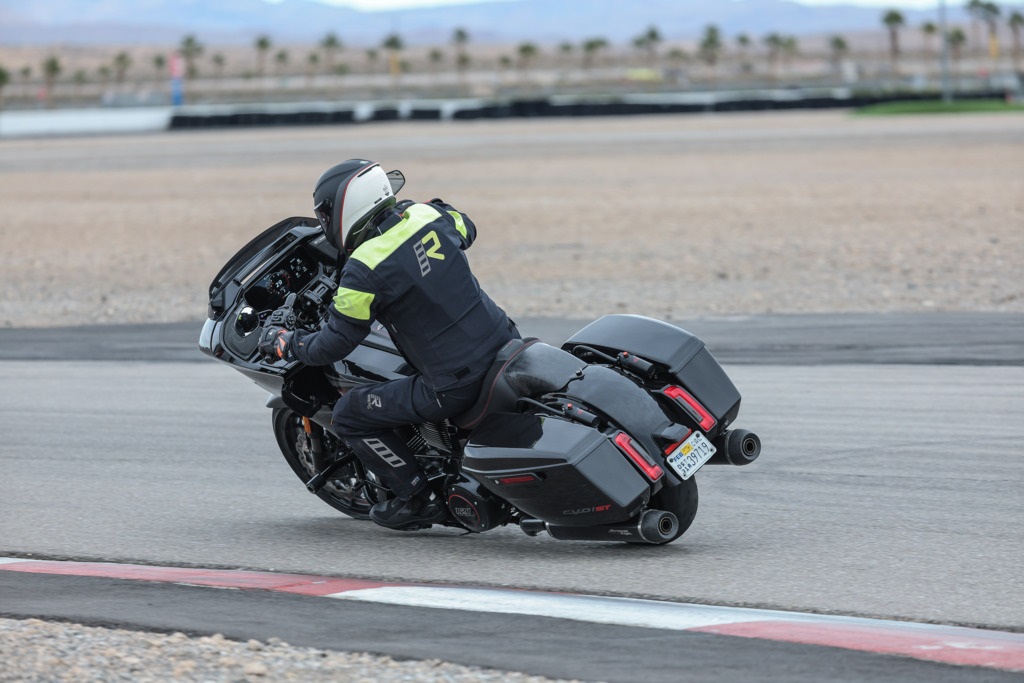
Based on the standardized test Harley-Davidson uses to measure it, lean angle is 33 degrees on the right and 32 degrees on the left. This photo gives you an idea of what that amount of lean looks like, right before the floorboard starts dragging. When it does touch, it folds out of the way and doesn’t upset the chassis. Photo by Brian J. Nelson.
More than any other Harley-Davidson engine I’ve experienced, the 121 HO is happy in the upper end of the rev range. It’s still a big V-twin, but it revs quickly enough and stays smooth to redline. That led to me banging into the rev limiter an embarrassing number of times because the engine was sending me no messages of distress and I was too busy trying to watch Rispoli’s lines to pay attention to the tachometer.
A few of the compromises made between bagger tradition and bagger performance led to drawbacks that were revealed on the track but might not be an issue at all for the vast majority of CVO Road Glide ST owners who ride only on the street. For me, the one design element that made the ST harder to ride at pace on the track was the traditional position of the gear shift lever. One of the decisions the design team debated was whether the CVO should have floorboards or footpegs. Ultimately, they compromised and chose floorboards that are smaller than usual. Their forward position is not extreme, but it’s also not ideal for shifting weight side by side. More importantly, the position of the gear shift lever above the floorboard means there’s no hope of quickly snicking up through the gears with the flick of a toe. I had to move my foot and raise my entire lower leg to shift gears, and as a result I missed a few shifts and unintentionally found neutral a couple of times. The same issues would apply to the brake pedal, but I avoided that by relying on the linked brakes. As noted above, I felt that was an impediment on the track, but for riders who stick to street riding and are accustomed to floorboards, it could well be a non-issue and feel perfectly natural.
Another choice that doesn’t fit with on-track performance is the high handlebar, which could be described as a mini-ape-hanger. Again, riders’ usage and personal preference will determine their feelings on the riding position, but to me it felt too high, especially on the track.
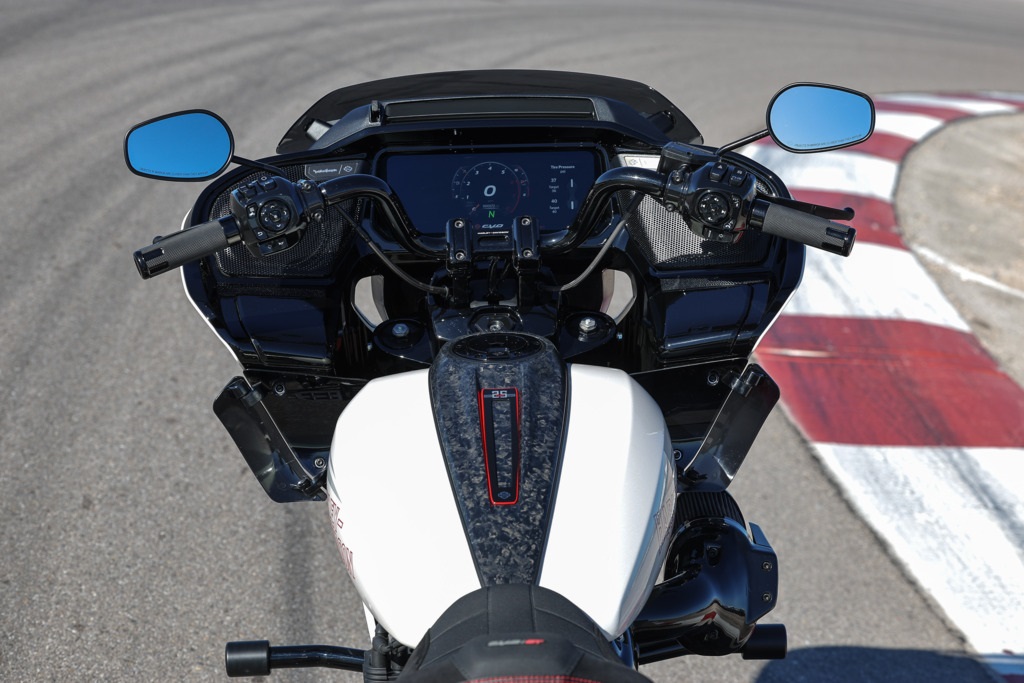
Items to note from the rider’s perspective: The handlebar rise is quite high, the touchscreen display is full-color and impressively large, and the forged carbon fiber trim on the tank is a unique touch. Photo by Brian J. Nelson.
My final nitpick is the clutch lever action, which reminded me far too much of the 1991 Harley-Davidson Sportster I owned decades ago. Harley-Davidson switched to hydraulic clutches on some of its top-end bikes in recent years, ran into some problems and some complaints, and went back to a cable-operated clutch. I can be happy with cable or juice clutches, and I might not normally criticize this one, if it were on a lesser bike, but we’re talking about a $43,000 motorcycle. Touchpoints like levers are among the elements that add to or detract from the feel of quality and sophistication, and reminding me of a motorcycle I owned more than 30 years ago and that cost less than a tenth of this one’s price is not a good feel.
So to answer my second question, was riding the CVO Road Glide ST, the heaviest bike I’ve ridden in several years and the most expensive motorcycle I’ve ridden ever, the nerve-wracking handful I thought it might be? Not at all. The smooth power delivery, solid brakes, and stable suspension made it all drama-free. I’m sure I could make it all go sideways if I increased the pace, but I wasn’t about to try to put a pass on James Rispoli and get kicked out of a Harley-Davidson press event before dinner.
Is the CVO Road Glide ST the ultimate performance bagger?
Here’s the thing with Harley-Davidson’s CVO models. Before you even started reading this review, you already knew if a there was even a chance in hell that you’d ever buy one. They’re not for most people, or even many people. The CVOs are what I call “bragging rights bikes,” for customers who have the cash to buy whatever they want and want something special. Something no one else at Bike Night is going to have.
In that context, the price is almost irrelevant. And while I choke hard on the idea of spending $43,000 on a motorcycle, others who are into the bagger scene point out that it is easy to spend that much to take a traditional bagger and upgrade the engine, suspension, and brakes to move it into the performance realm.
Motorcycling is full of riders who will say that including the word “performance” and an 800-plus-pound wet weight in the same discussion is ridiculous. Harley-Davidson’s customer base is also full of riders who wouldn’t understand why you’d ever want to rev to redline. The number of people with 43,000 disposable dollars who don’t fit into those two bigger groups is probably quite limited. But that doesn’t matter. Harley-Davidson doesn’t have to sell many CVO Road Glide STs. That’s why it’s a limited edition.
| 2024 CVO ROAD GLIDE ST | |
| Price (MSRP) | $42,999 |
| Engine | Milwaukee-Eight High Output 121 1,977 cc, air-and-liquid-cooled, eight-valve, V-twin |
| Transmission, final drive | Six-speed, belt |
| Claimed horsepower | 127 @ 4,900 rpm |
| Claimed torque | 145 foot-pounds |
| Electronic rider aids | Five ride modes; electrically linked brakes; lean-angle-sensitive traction control; lean-angle-sensitive ABS |
| Frame | Steel tubular |
| Front suspension | Showa 47 mm inverted fork with adjustable preload, compression, and rebound damping; 4.6 inches of travel |
| Rear suspension | Showa shock adjustable for preload, compression, and rebound damping; 3.0 inches of travel |
| Front brake | Brembo dual radial-mount four-piston calipers, 320 mm discs, with ABS |
| Rear brake | Brembo single-piston caliper, 300 mm disc, with ABS |
| Rake, trail | 26 degrees, 6.7 inches |
| Wheelbase | 64 inches |
| Seat height | 28.3 inches |
| Fuel capacity | 6.0 gallons |
| Tires | Dunlop D408F 130/60B19 front, Dunlop 407T 180/55B18 rear |
| Claimed weight | 838 pounds wet |
| More info | harley-davidson.com |

Not a rider friendly bike to ride
It’s funny, because on one hand, it is intimidating because of the weight. And the limited lean angle, position of the floorboards and gear shift lever, and the high handlebar make it a little awkward on the track (less so on the street, I’m sure). But at the same time, it was more rider-friendly than I was afraid it would be. It feels light on its feet for 800 pounds and that’s easily the best Harley-Davidson engine I’ve tested (I haven’t ridden the Pan America.)
Wow 43k. This sounds like the engine I want from Harley but that’s not in my budget bracket.
The engine’s great. We often see engines and features and styles debut in the CVO models and then trickle down to lesser models in later years, so you might be able to get the 121 HO engine in a more affordable H-D package in a couple of years.
Interesting about the softer response at small throttle openings. That’s precisely how I set up the throttle on my Road King. I want to be able to gently modulate power. This is true when coming out of corners or even just starting off with my wife riding pillion. The way I have my throttle set up is softer for the first quarter turn. The factory setting for the next two quarters and more aggressive for the last quarter of throttle opening. To me that’s a logical way to set up the throttle in general. It makes you smoother when adding the power. If you’re racing, whether it’s on two wheels or four, smoother is usually faster.
I feel like the Sport mode on the CVO Road Glide is designed to give the maximum sensation of performance, rather than maximum actual performance. It gives you a real kick in the pants when opening the throttle from a stop, for example. It’s not the easiest way to set the fastest lap time, but that probably won’t matter to many owners. I’d probably never use Sport mode if I were riding this motorcycle all the time. But in the same way some Harley-Davidson riders like to lug their engines at low rpm and big throttle openings to feel the low-end torque, that kick at initial throttle opening provides a feeling of power, and I’m sure some riders will like it.
I hear what you say, but I like a soft throttle setting on initial opening. I have the Road King set up like that. I modified the throttle on my Ducati to be more like that. Heck I even started playing with radio control plans and have the throttle set like that for them. A couple of years ago I got your ride Dennis Martin’s personal Triumph Speed Twin. He had it set up for sport. I put it back on the regular Road setting. I thought the sports setting was a little too choppy. The one place I’m different is on our Mini Cooper S. I always run that on sport mode. It just feels right.